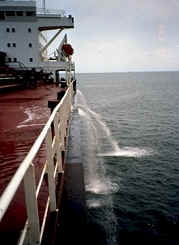Still working to recover. Please don't edit quite yet.
Ecological impact of ballast water discharge
Wikipedia:Ballast water discharges by ships can have a negative impact on the Wikipedia:marine environment.
Cruise ships, large tankers, and bulk cargo carriers use a huge amount of ballast water, which is often taken on in the coastal waters in one region after ships discharge wastewater or unload cargo, and discharged at the next port of call, wherever more cargo is loaded. Ballast water discharge typically contains a variety of biological materials, including Wikipedia:plants, animals (WP), Wikipedia:viruses, and Wikipedia:bacteria. These materials often include non-native, nuisance, exotic species that can cause extensive ecological and economic damage to aquatic ecosystems.
| This article contains content from Wikipedia An article on this subject has been nominated for deletion on Wikipedia: Wikipedia:Articles for deletion/ Environmental issues with shipping Current versions of the GNU FDL article on WP may contain information useful to the improvement of this article |
WP+ NO DEL |
Contents
Problematic species[edit]
There are hundreds of organisms carried in ballast water that cause problematic ecological effects outside of their natural range. The Wikipedia:International Maritime Organization list the ten most unwanted species as:[1]
- Cholera Wikipedia:Vibrio cholerae (various strains)
- Cladoceran Water Flea Wikipedia:Cercopagis pengoi
- Mitten Crab Wikipedia:Eriocheir sinensis
- Toxic algae (red/brown/green tides) (various species)
- Round Goby Wikipedia:Neogobius melanostomus
- North American Comb Jelly Wikipedia:Mnemiopsis leidyi
- North Pacific Seastar Wikipedia:Asterias amurensis
- Zebra Mussel Wikipedia:Dreissena polymorpha
- Asian Kelp Wikipedia:Undaria pinnatifida
- European Green Crab Wikipedia:Carcinus maenas
Ballast water issues by country[edit]
New Zealand[edit]
The ballast tanks in New Zealand carry animals and plants that kill ecosystems. Ballast tanks are only used in cargo ships there. Ballast water is controlled under the Wikipedia:Biosecurity Act 1993 in New Zealand.
Peru[edit]
A form of Wikipedia:cholera, Vibrio cholerae, previously reported only in Wikipedia:Bangladesh apparently arrived via ballast water in Wikipedia:Peru in 1991, killing more than 10,000 people over the following three years.[2]
United States[edit]
The Wikipedia:zebra mussel, native to the Caspian and Wikipedia:Black Seas arrived in Lake St. Clair in the ballast water of a transatlantic freighter in 1988 and within 10 years spread to all of the five neighbouring Wikipedia:Great Lakes. The economic cost of this introduction has been estimated by the Wikipedia:U.S. Fish and Wildlife Service at about $5 billion.
Ballast water discharges are believed to be the leading source of invasive species in U.S. marine waters, thus posing public health and environmental risks, as well as significant economic cost to industries such as water and power utilities, commercial and recreational fisheries, agriculture, and tourism.[3] Studies suggest that the economic cost just from introduction of pest mollusks (Wikipedia:zebra mussels, the Wikipedia:Asian clam, and others) to U.S. aquatic ecosystems is more than $6 billion per year.[4]
| This article contains content from Wikipedia. Current versions of the GNU FDL article Ballast water discharge and the environment on WP may contain information useful to the improvement of this article | WP |
See also[edit]
References[edit]
- ↑ International Convention for the Control and Management of Ships' Ballast Water and Sediments. International Maritime Organization. URL accessed on 2009-07-11. Template:Dead link
- ↑ Living Beyond Our Means: Millennium Ecosystem Assessment, 2005. Statement from the Board
- ↑ Statement of Catherine Hazlewood, The Ocean Conservancy, “Ballast Water Management: New International Standards and NISA Reauthorization,†Hearing, House Transportation and Infrastructure Subcommittee on Water Resources and Environment, 108th Cong., 2nd sess., March 25, 2004.
- ↑ David Pimentel, Lori Lach, Rodolfo Zuniga, and Doug Morrison, “Environmental and Economic Costs Associated with Non-indigenous Species in the United States,†presented at AAAS Conference, Anaheim, CA, January 24, 1999.
External links[edit]
- GloBallast partnership (IMO)
- International Convention for the Control and Management of Ships' Ballast Water and Sediments (BWM) (IMO)
- INTERNATIONAL CONVENTION FOR THE CONTROL AND MANAGEMENT OF SHIPS' BALLAST WATER AND SEDIMENTS, 2004
- Ballast Water Treatment Systems - Various types of Ballast Water Treatment Systems
- Optimarin Ballast System (OBS) - The Type Approved OptiMarin Ballast System
- GloBallast partnership (IMO)
